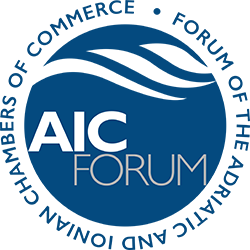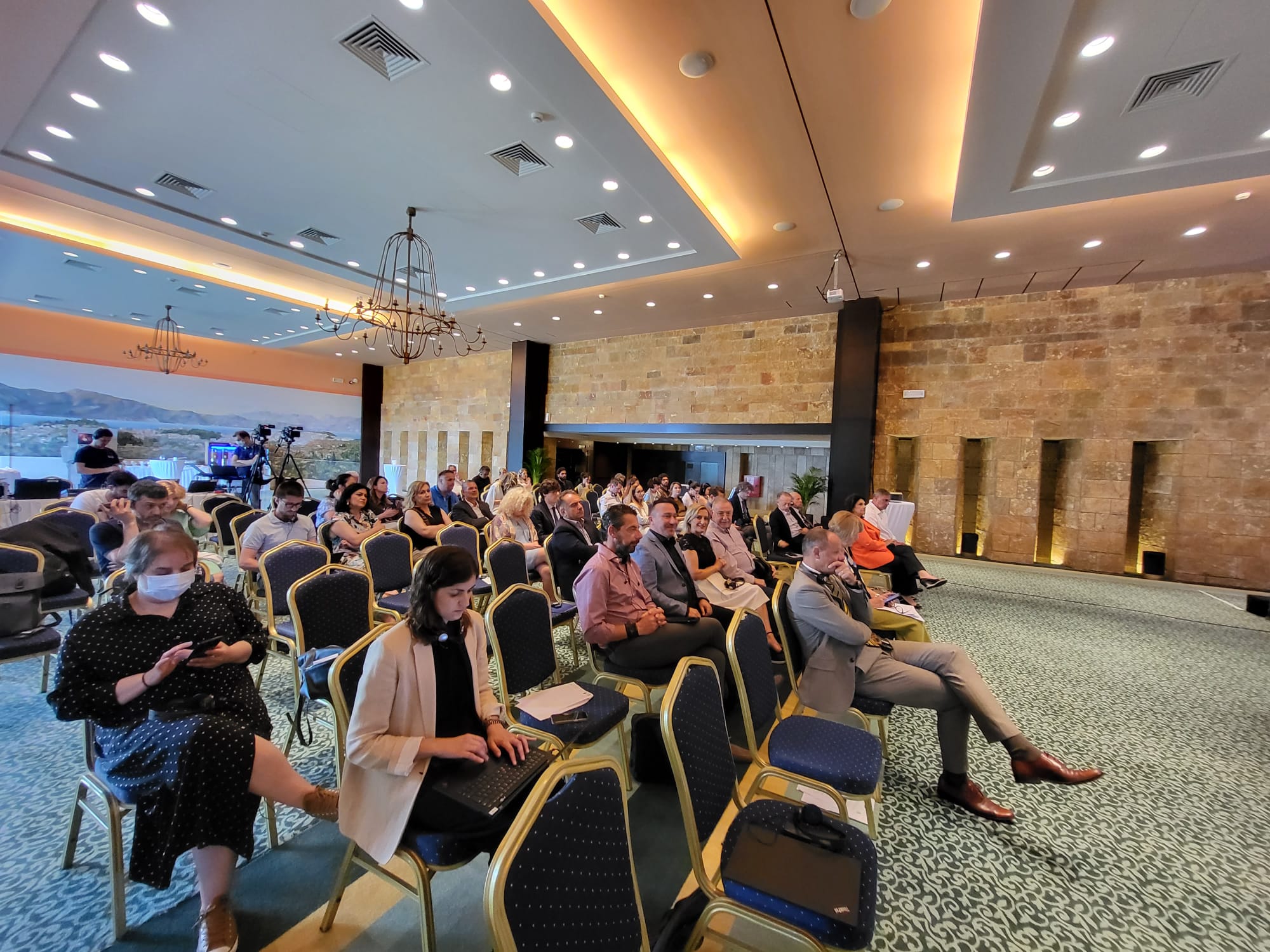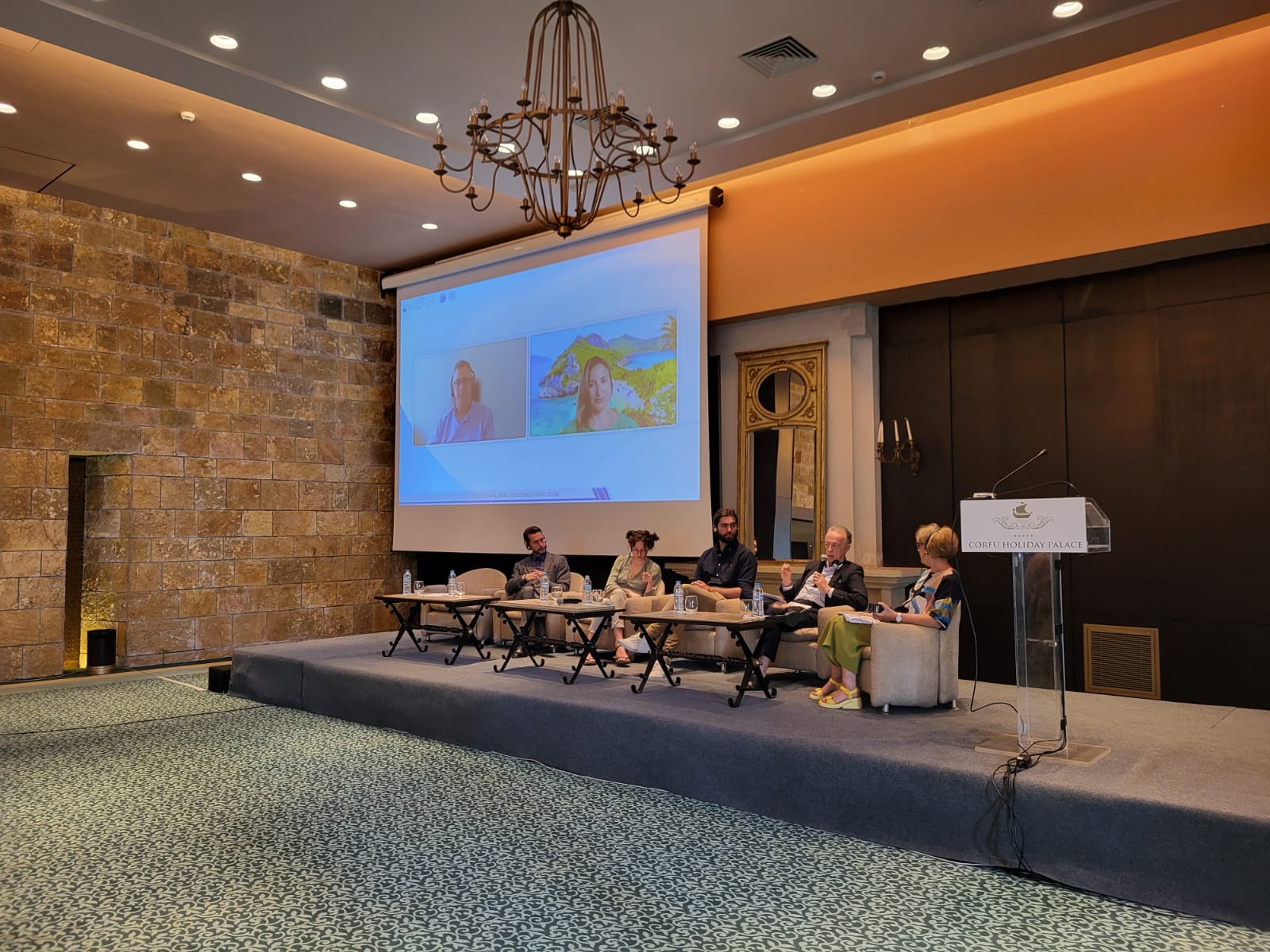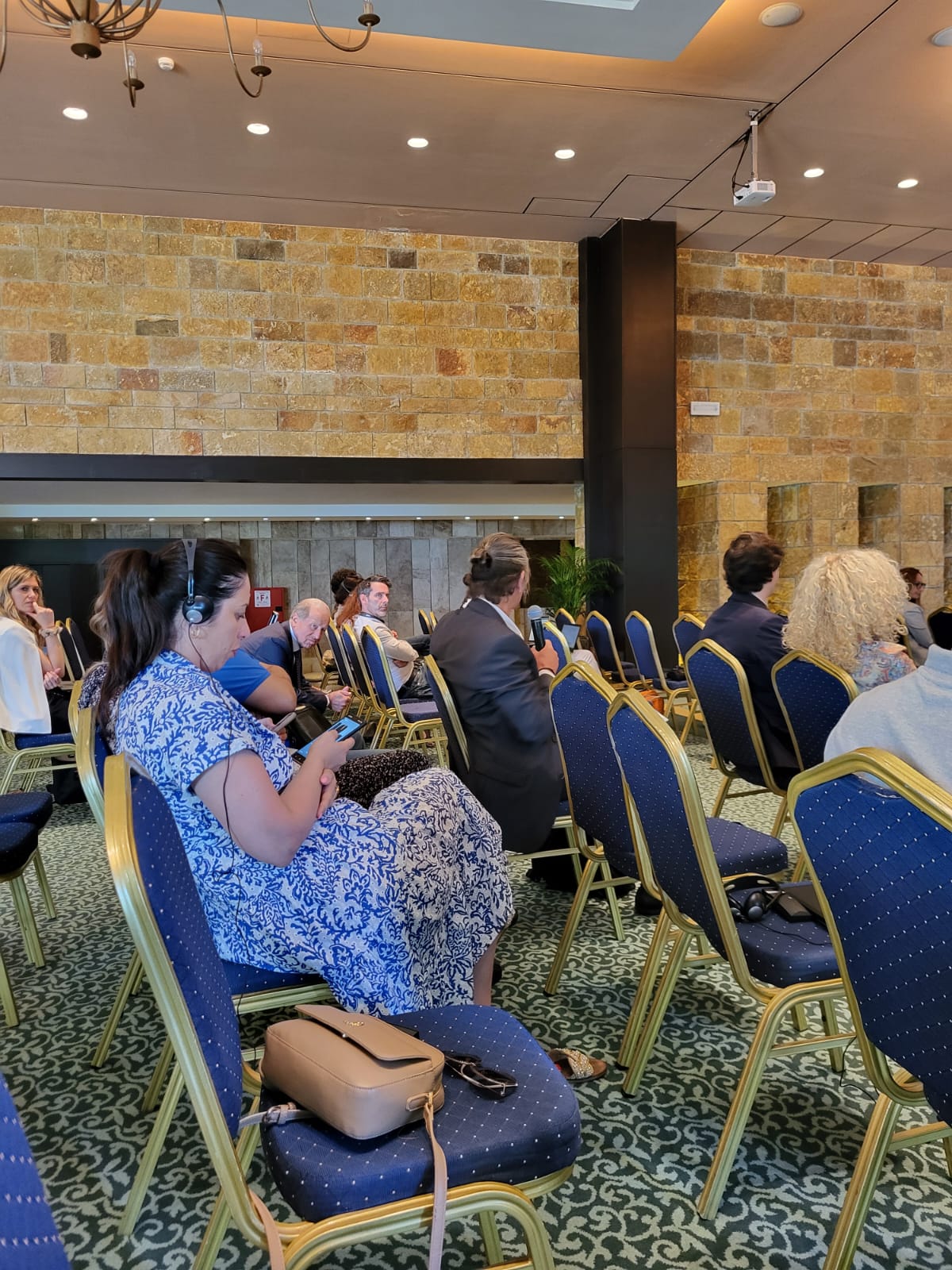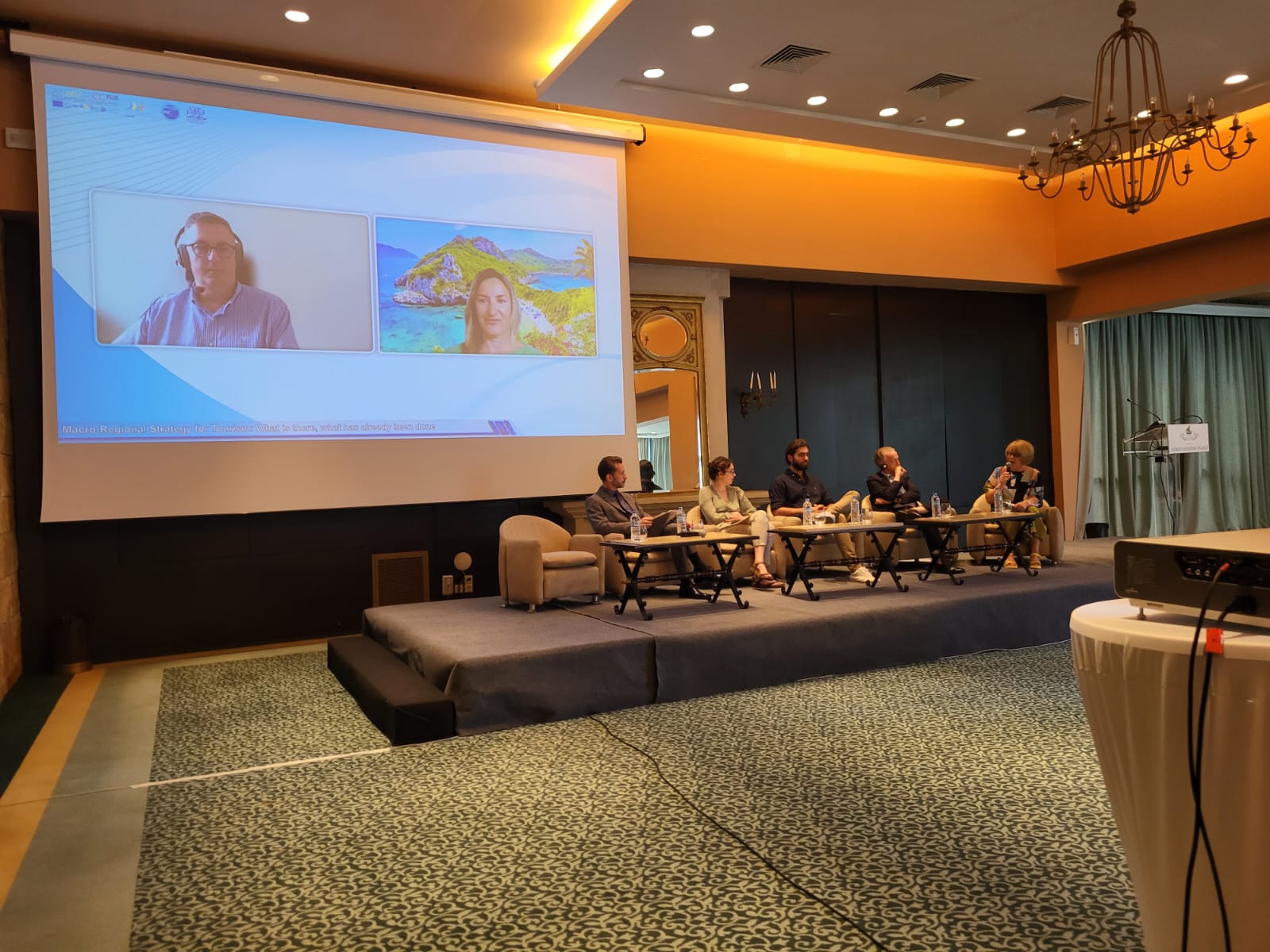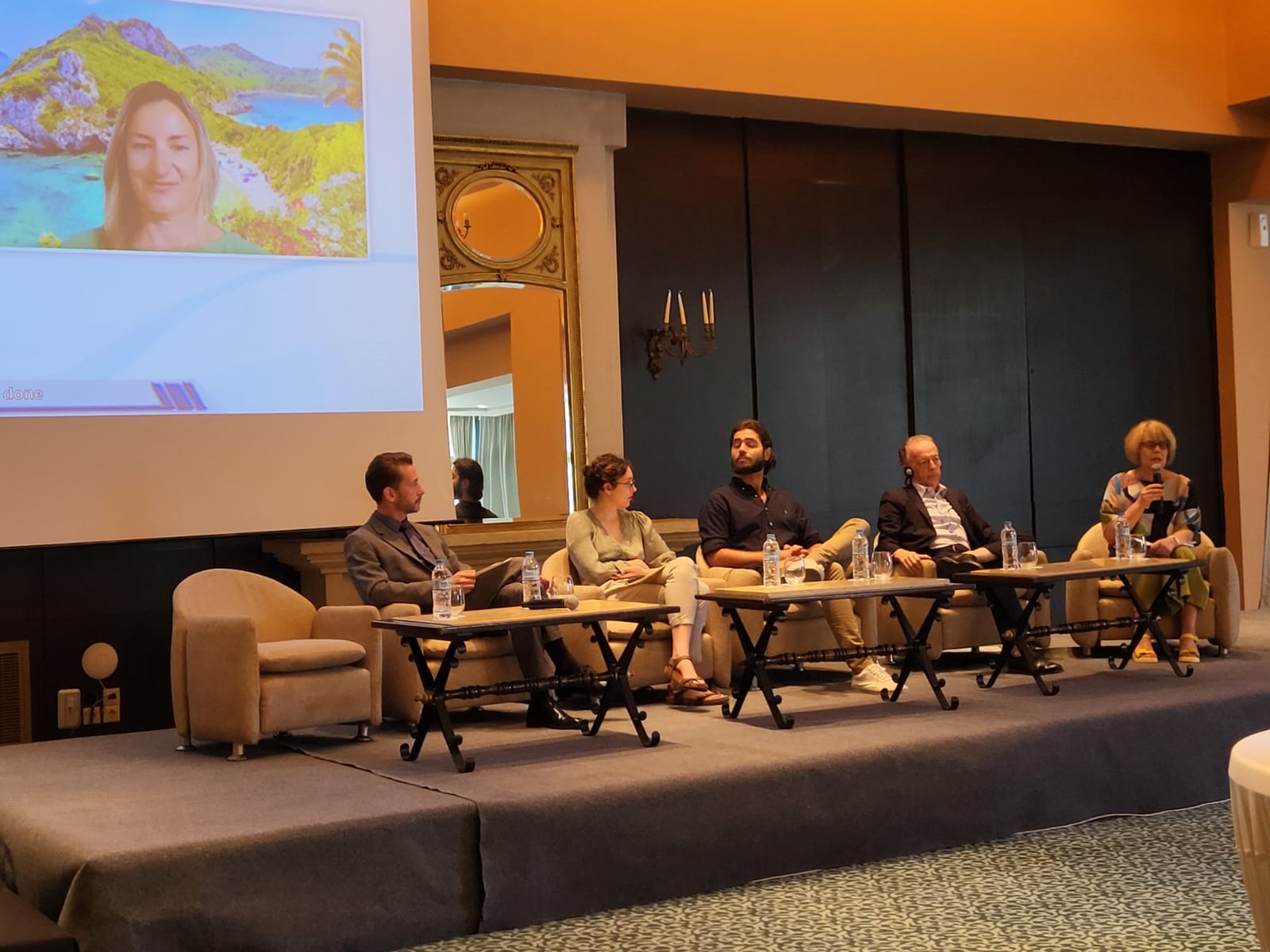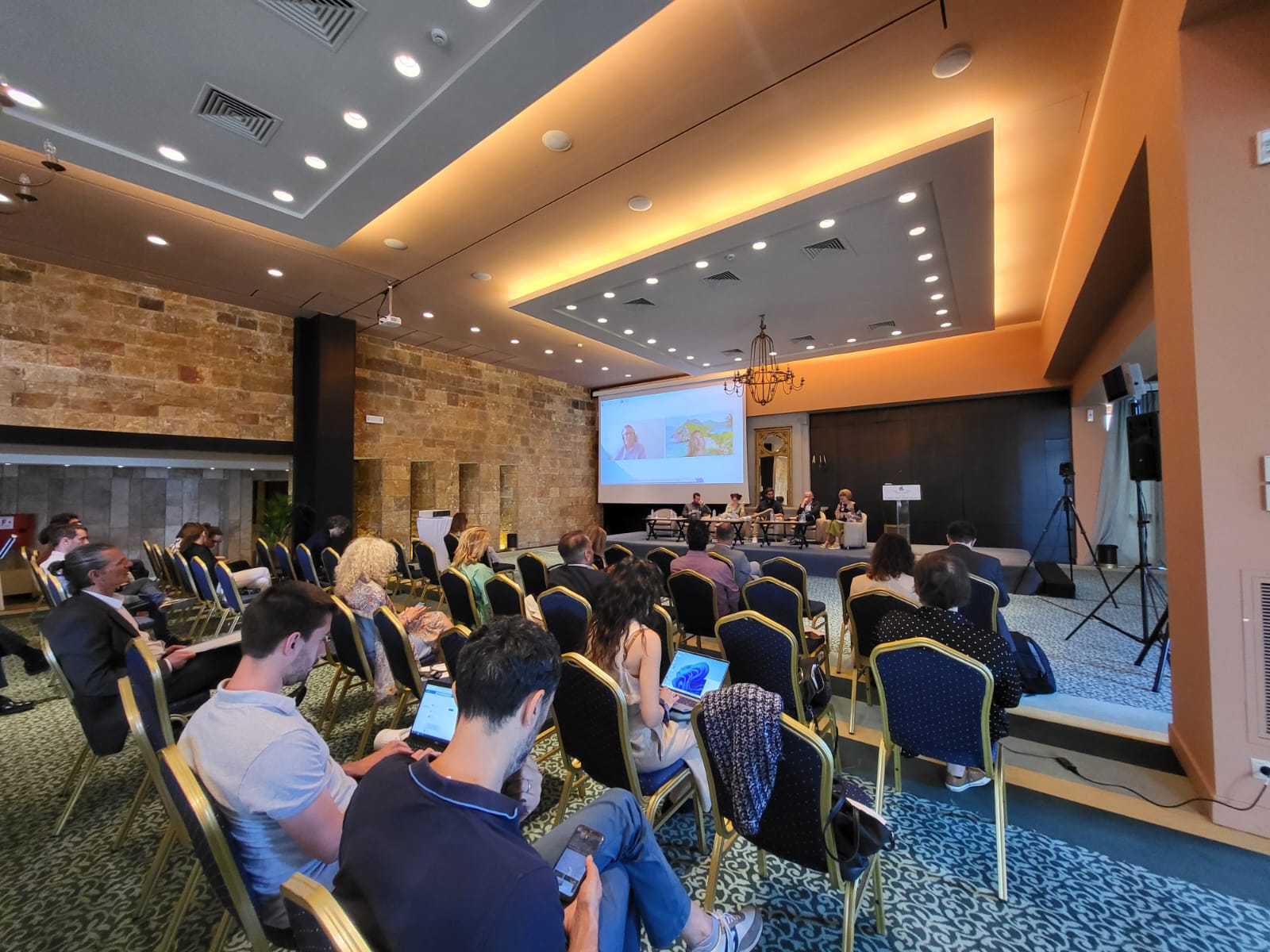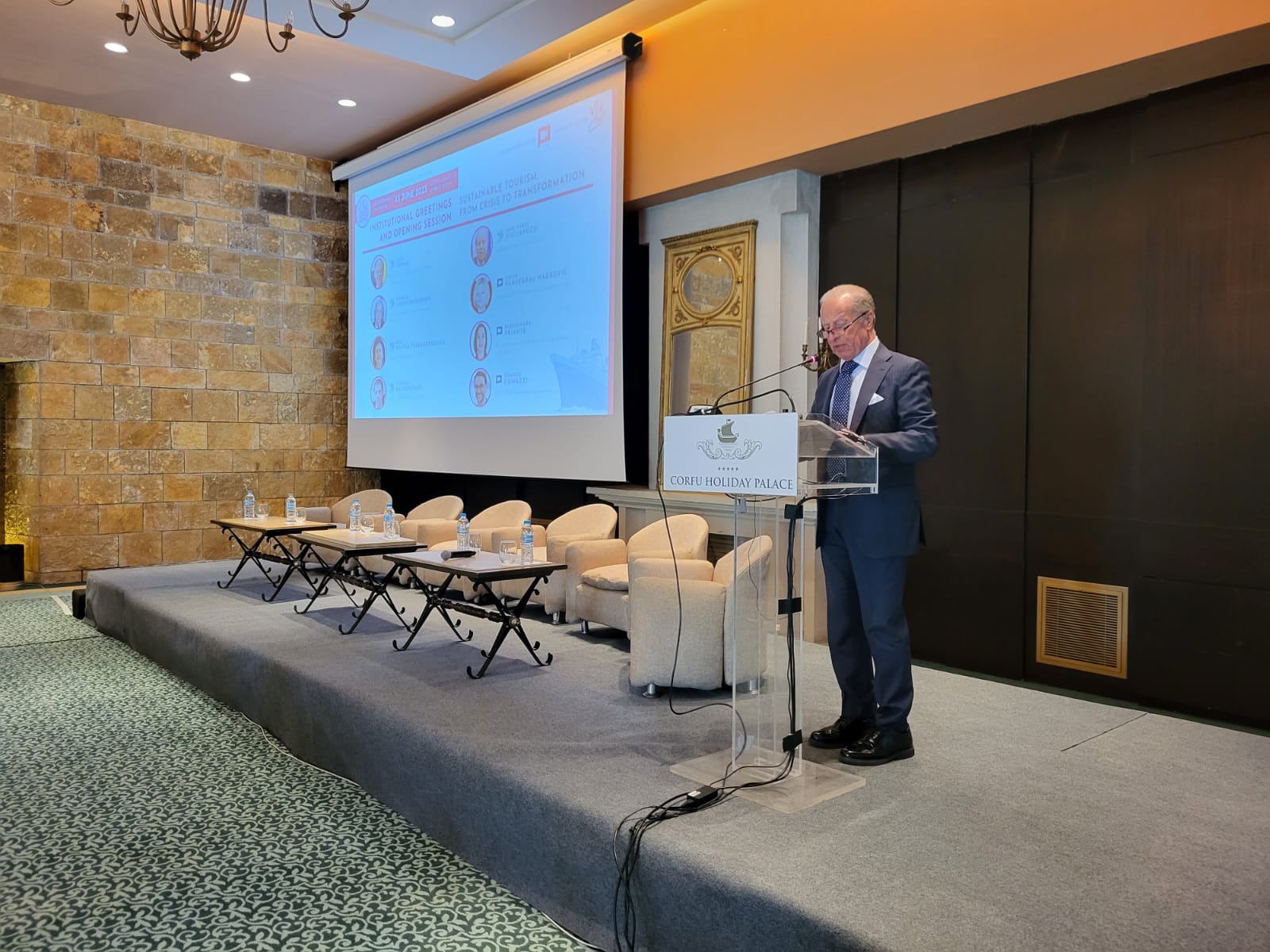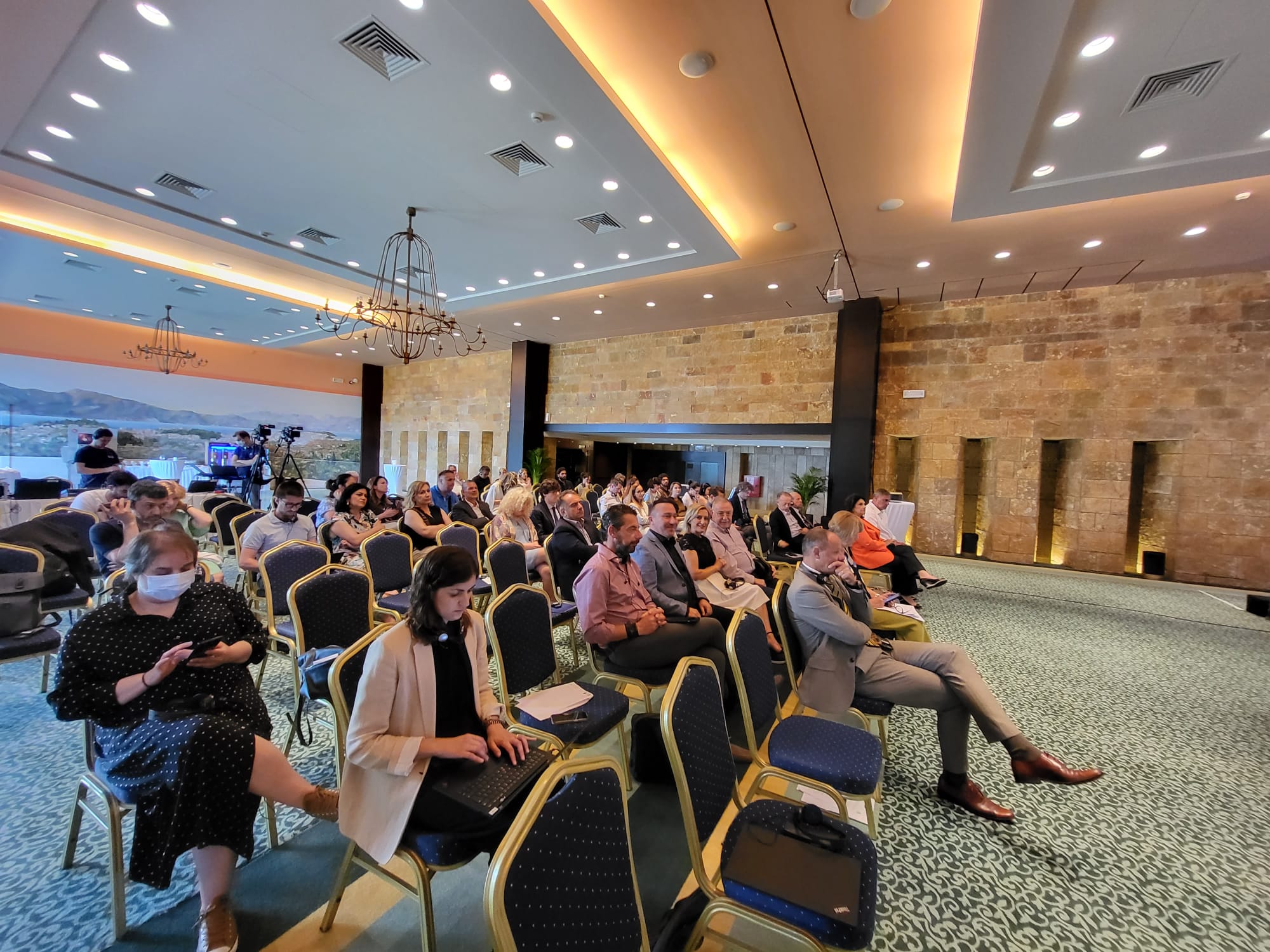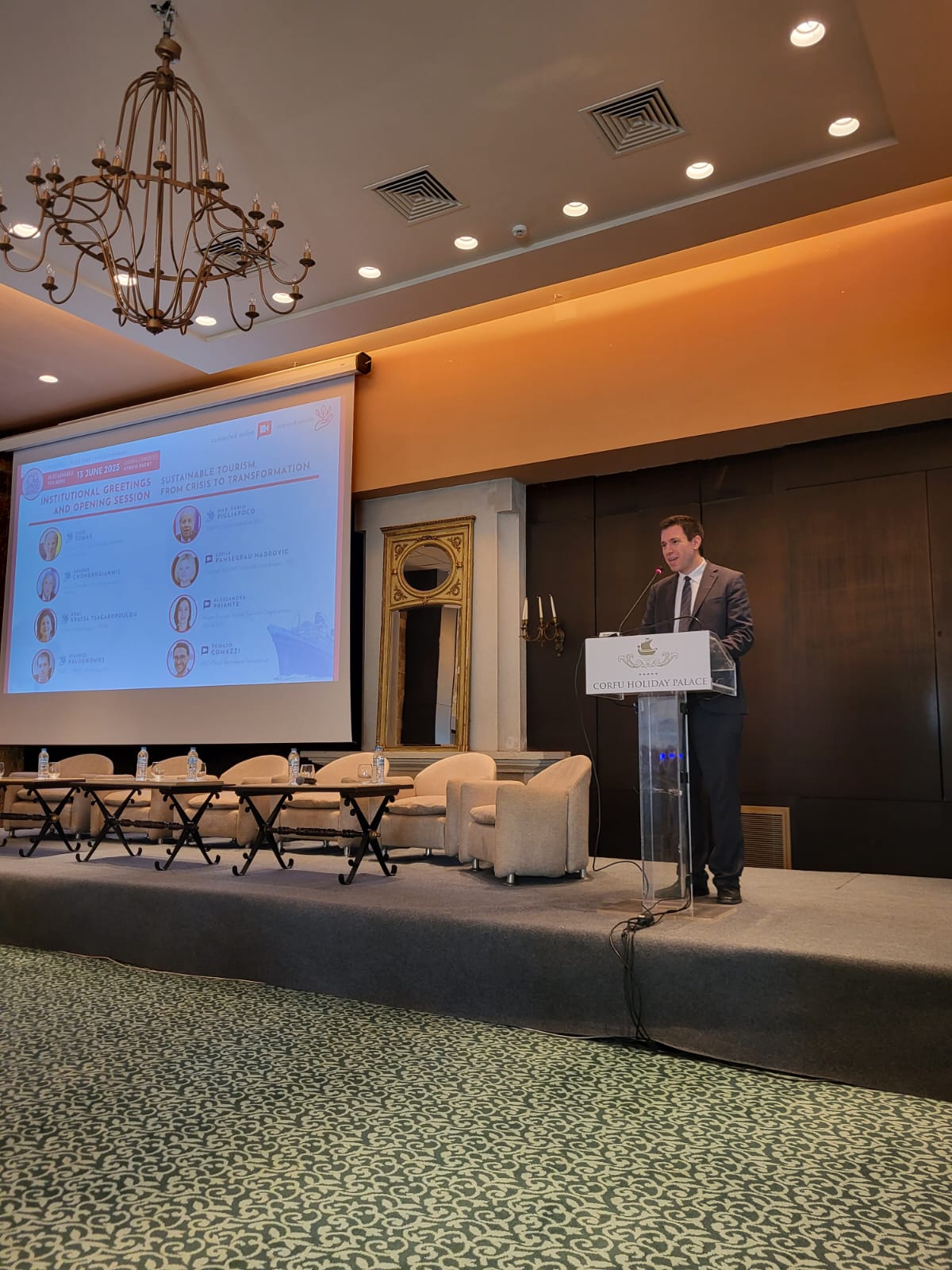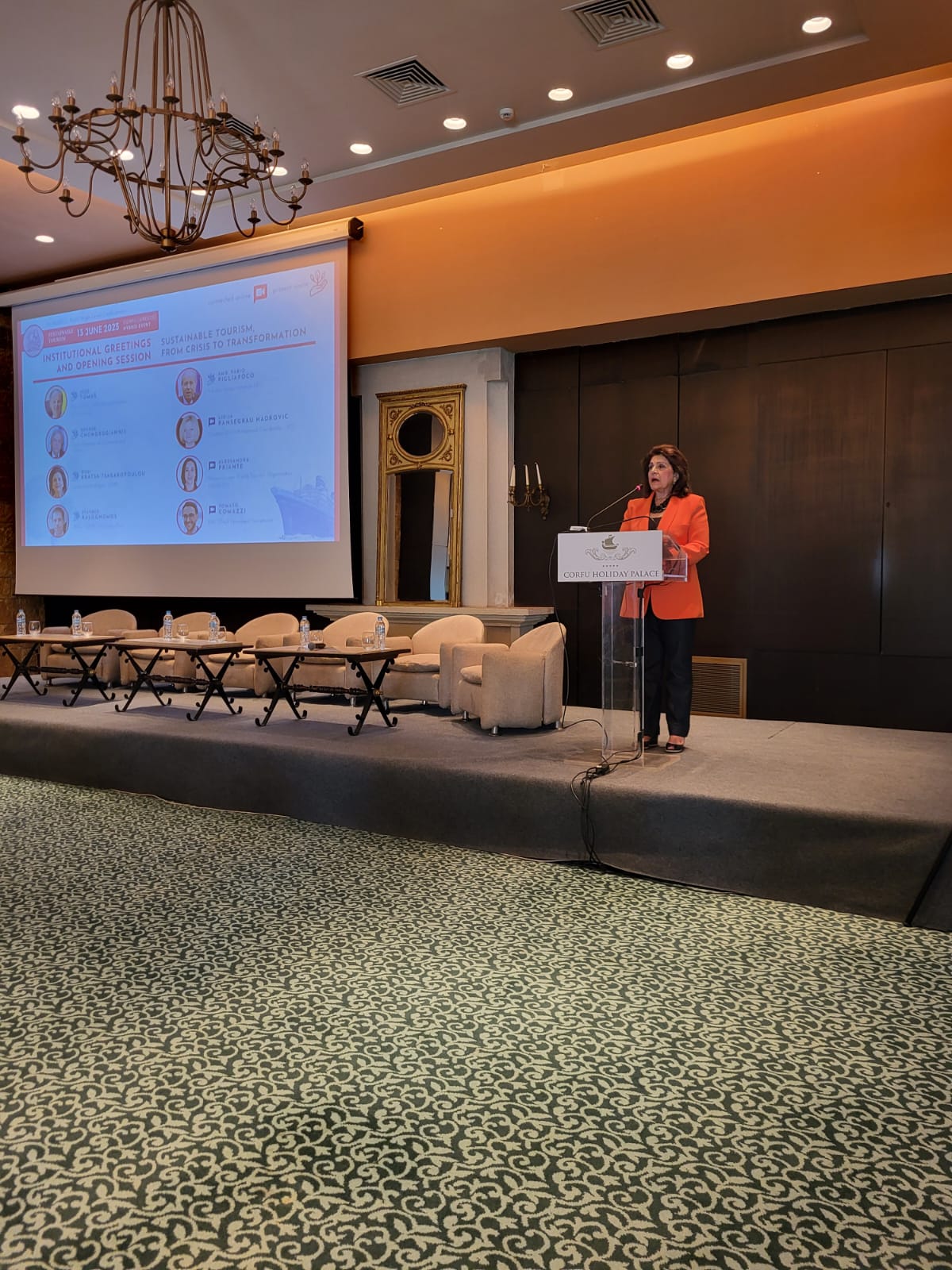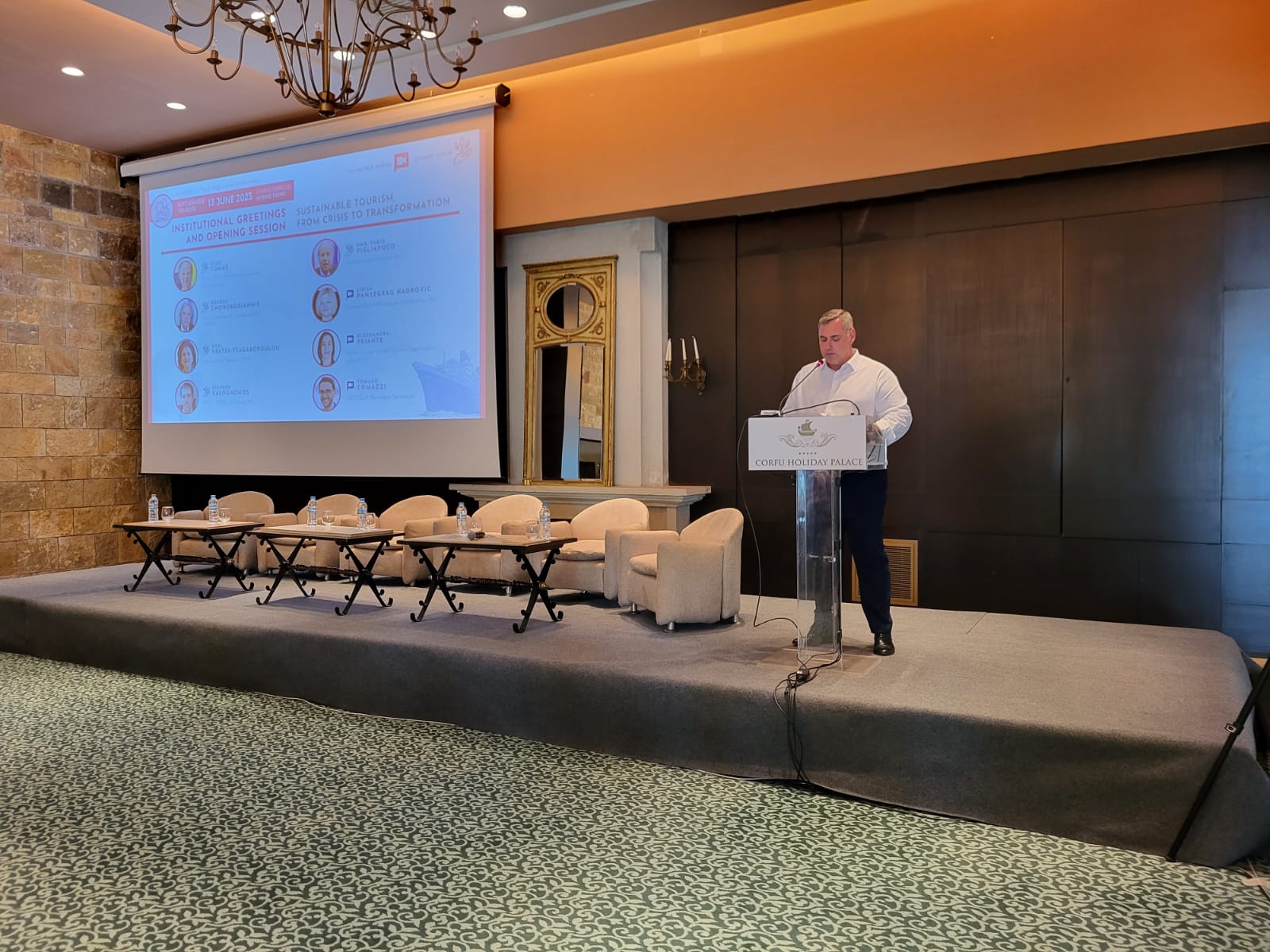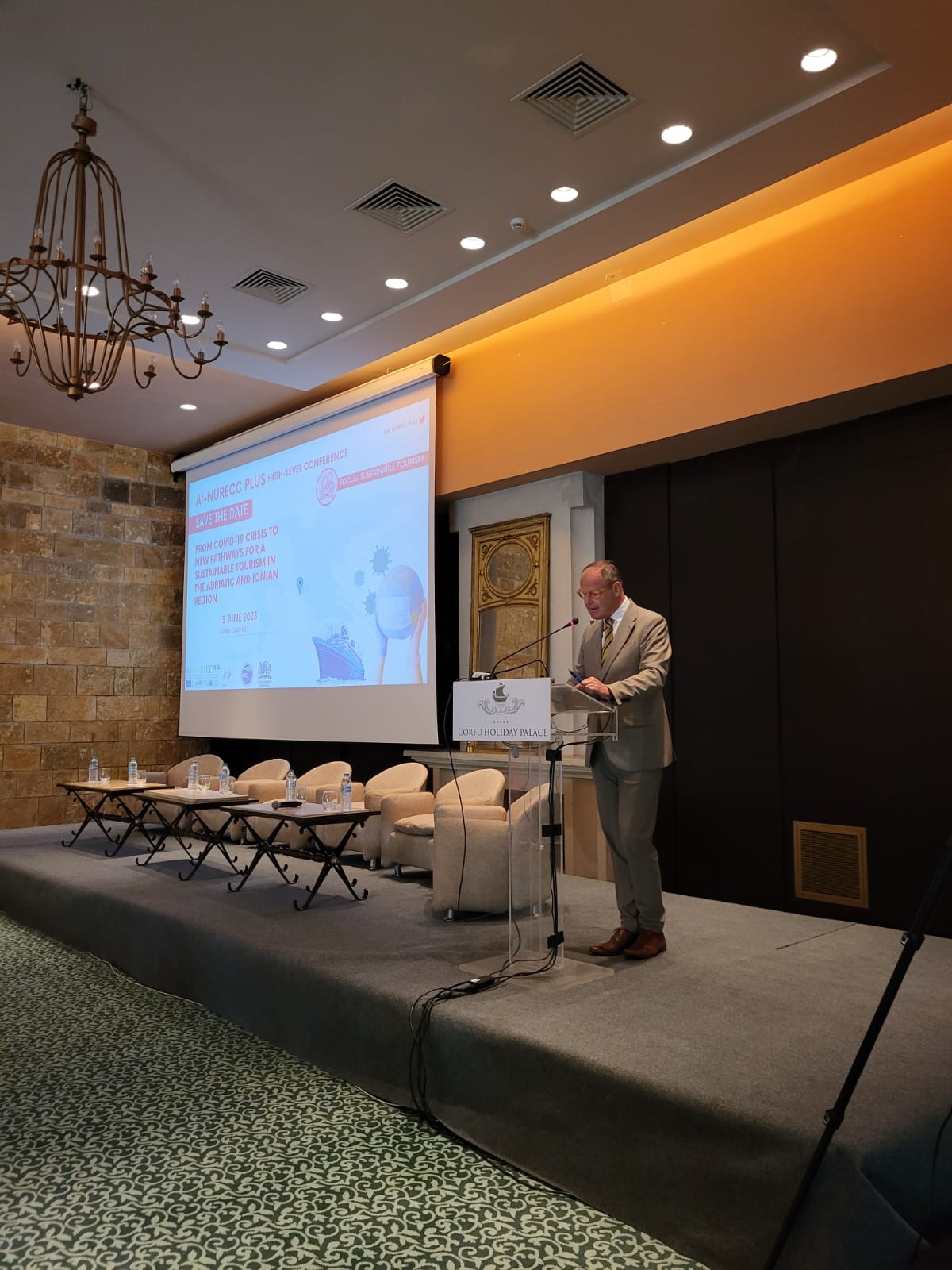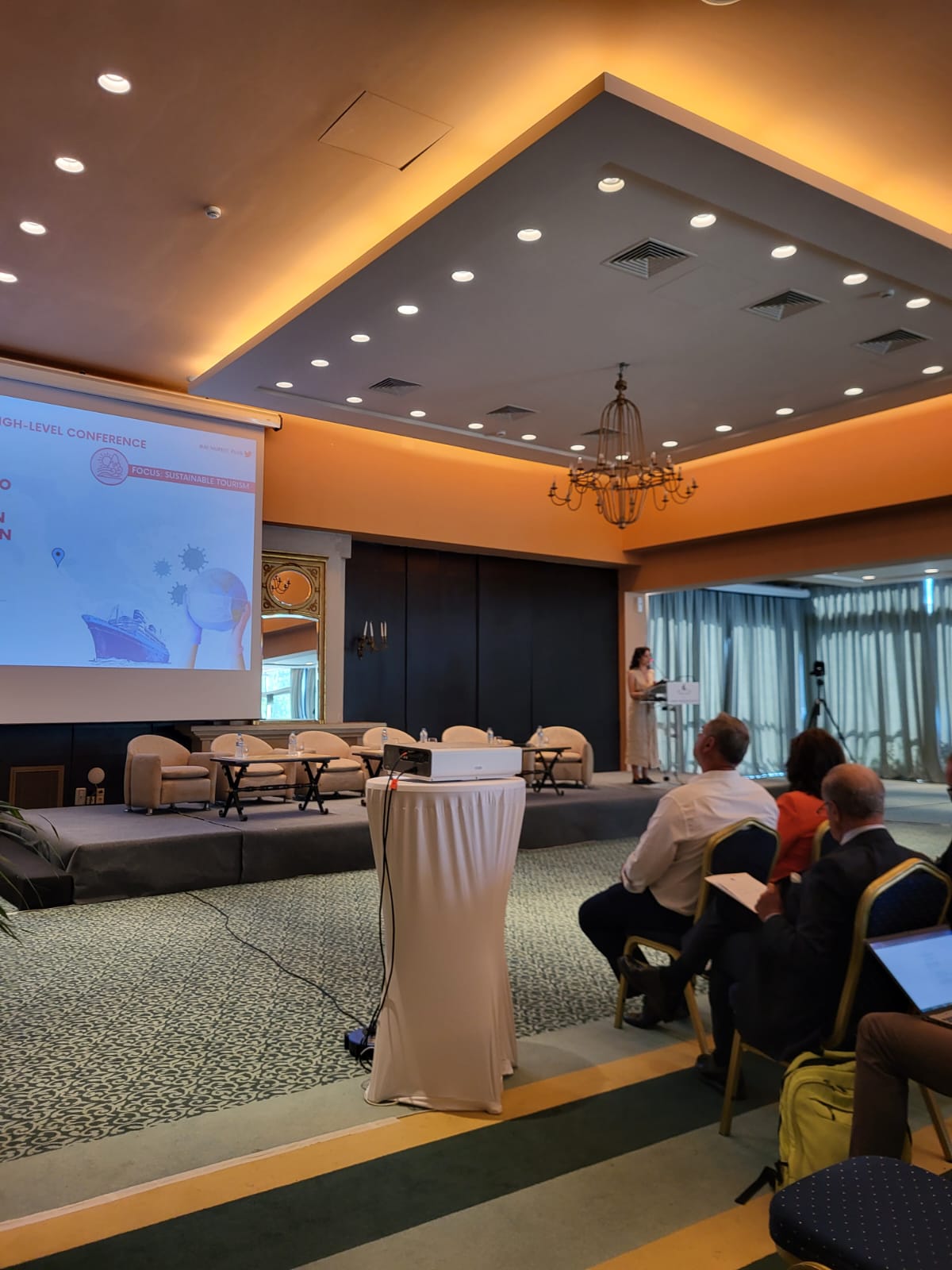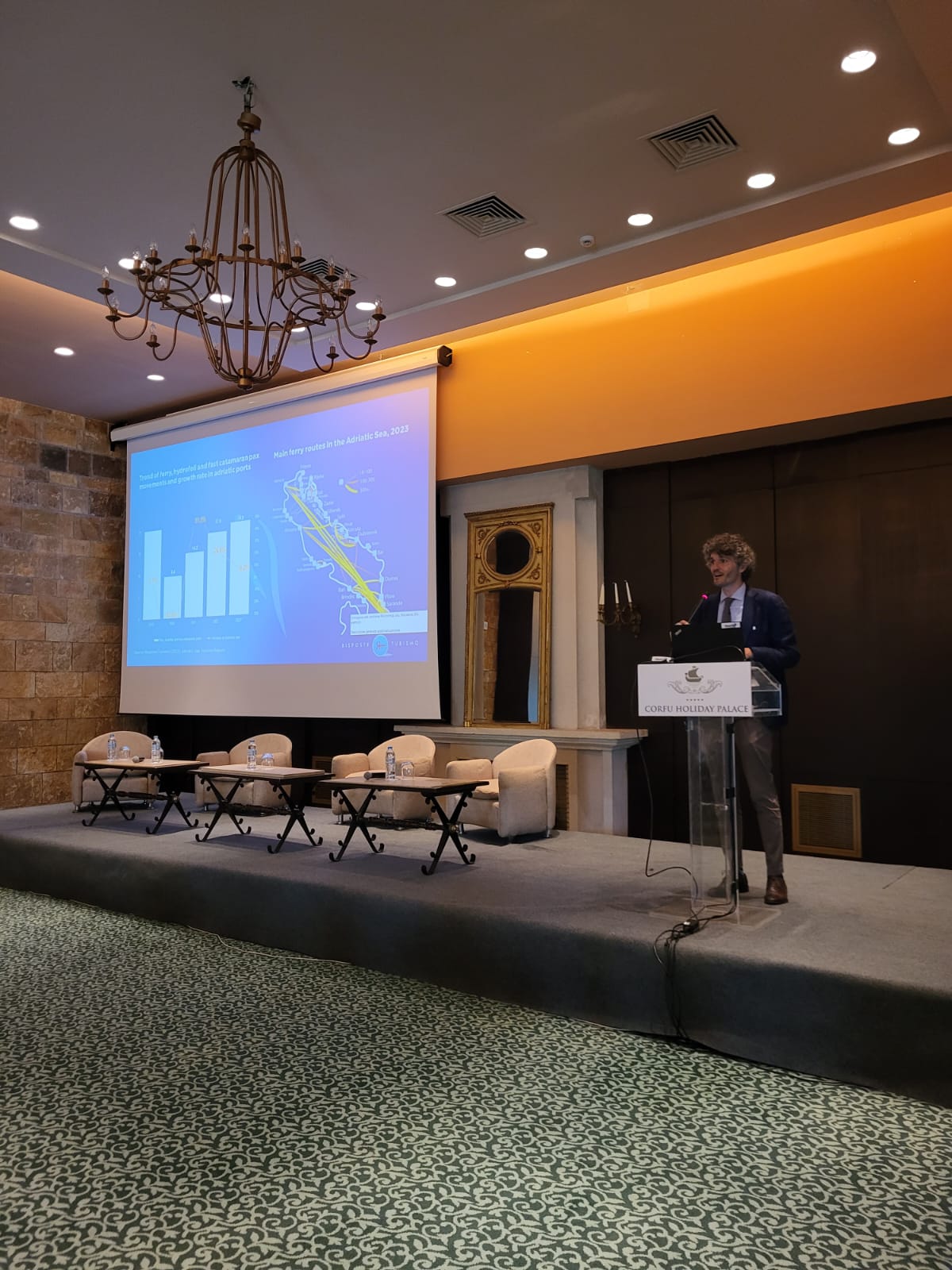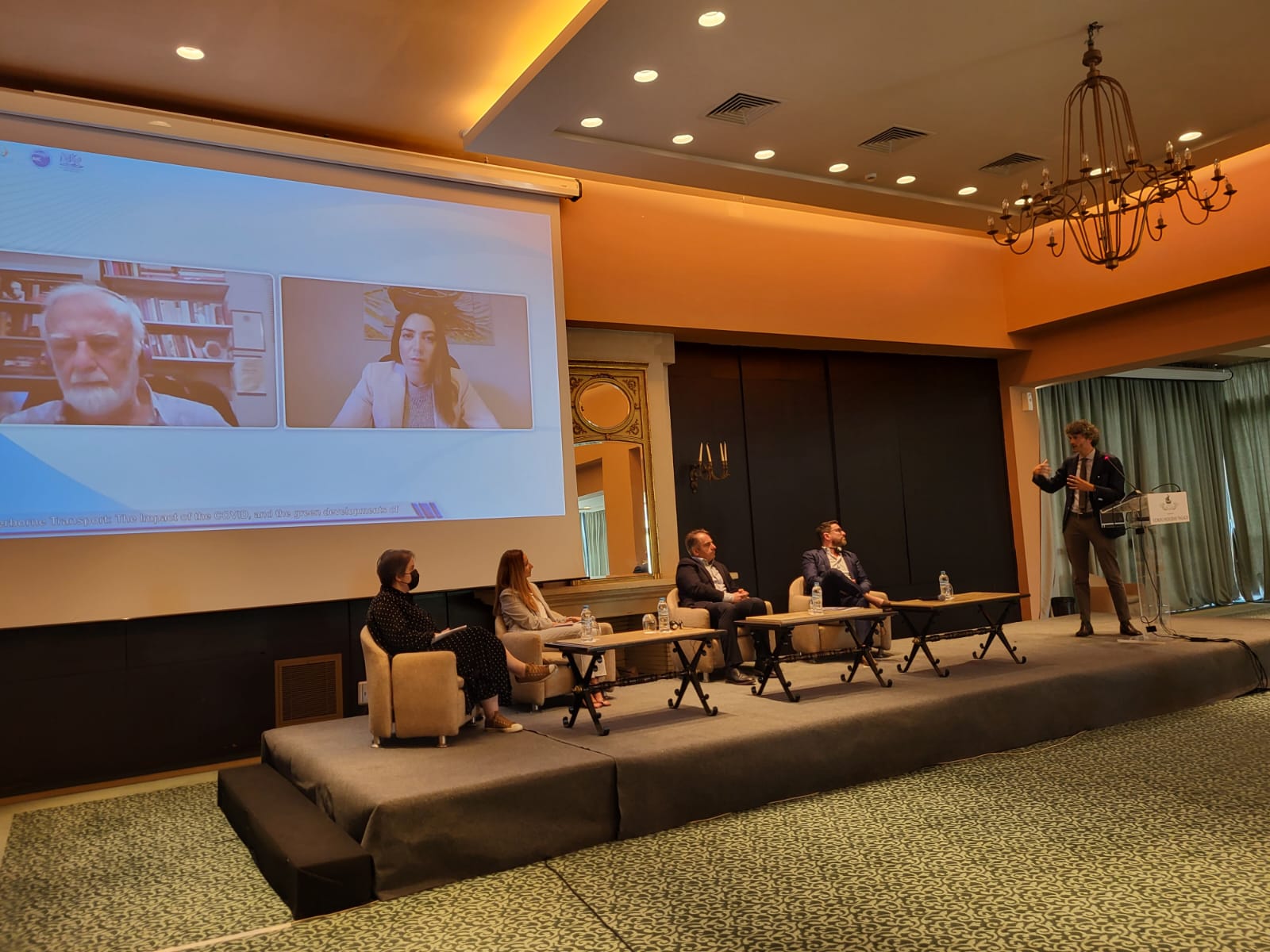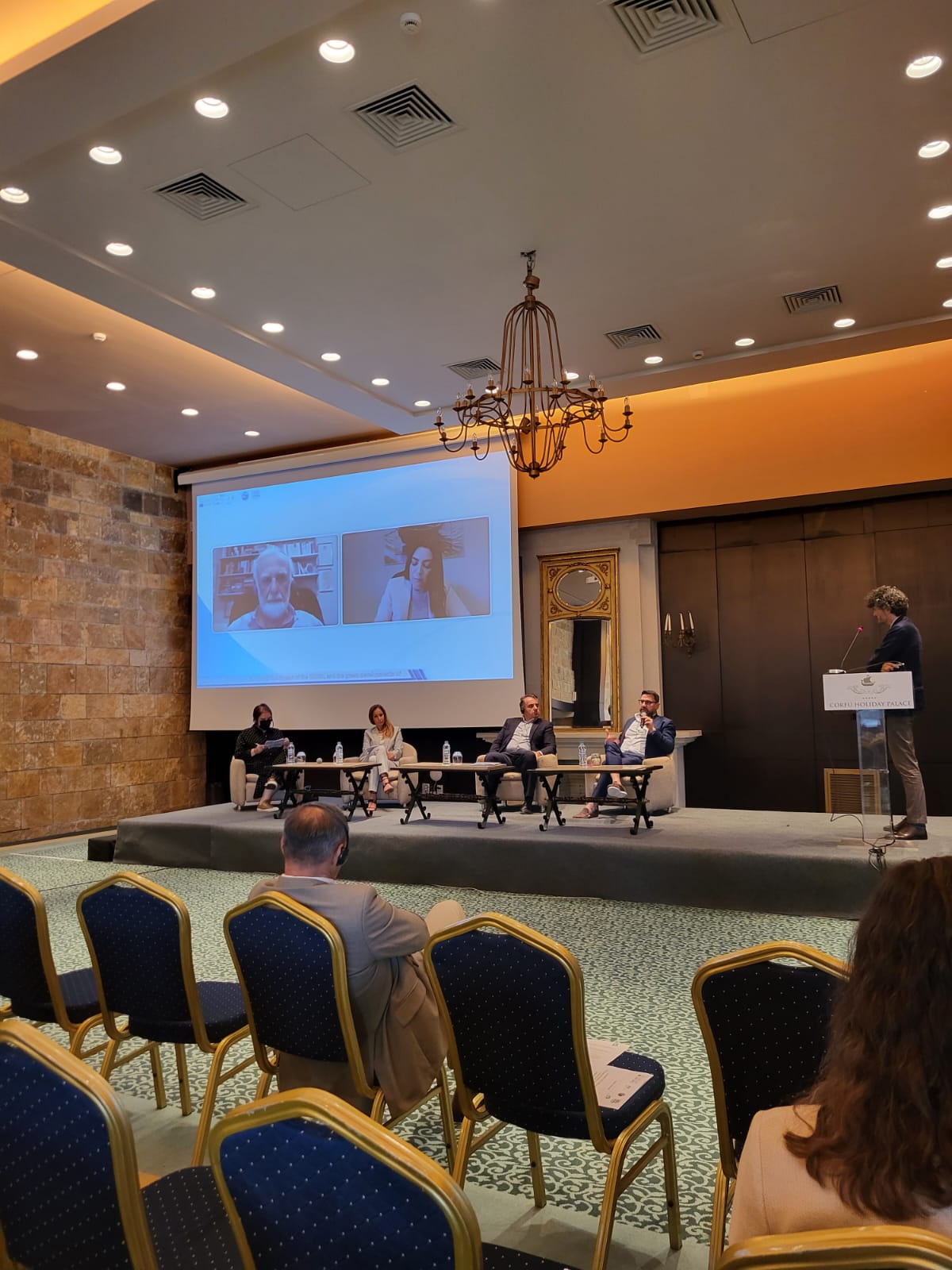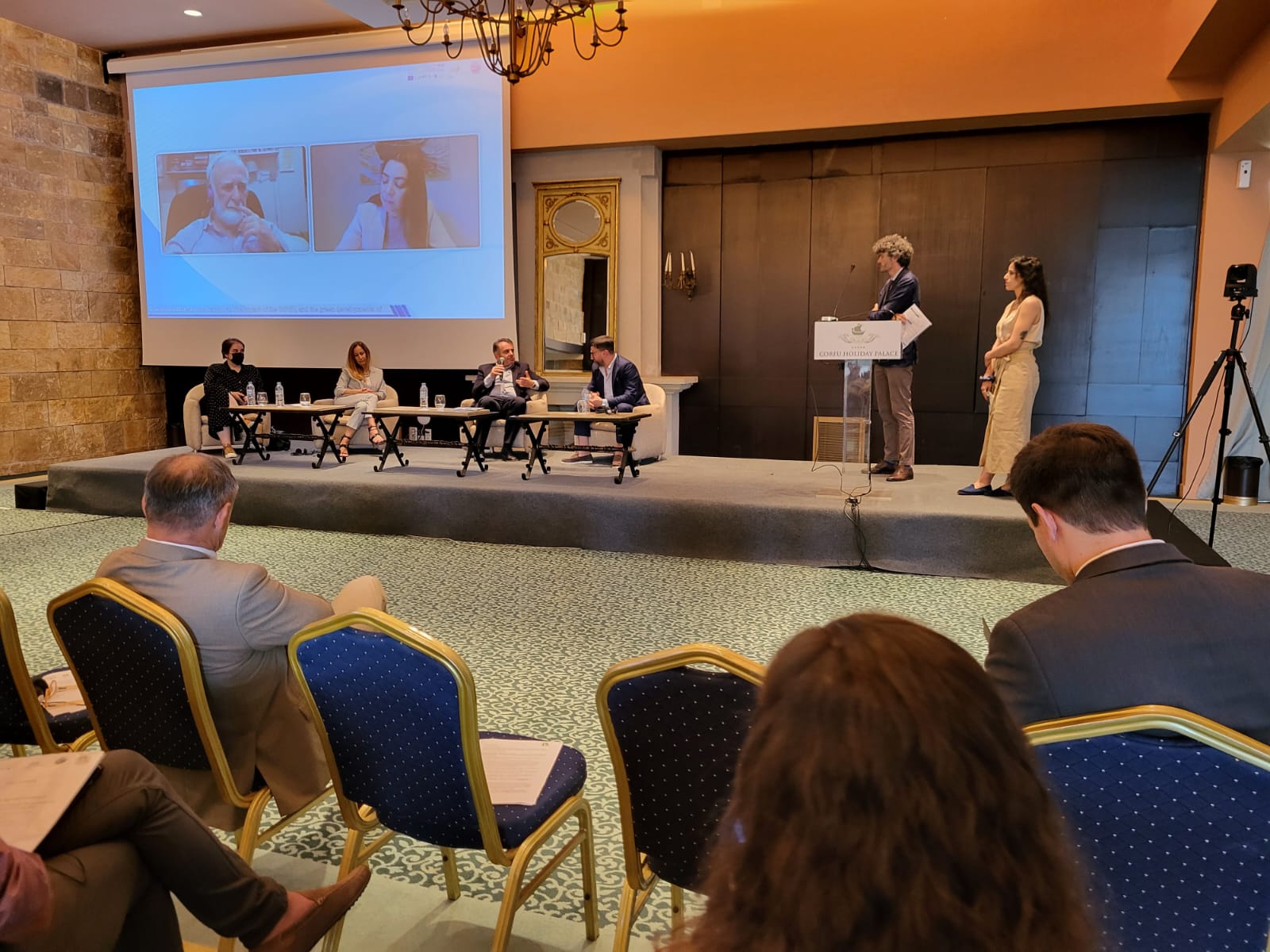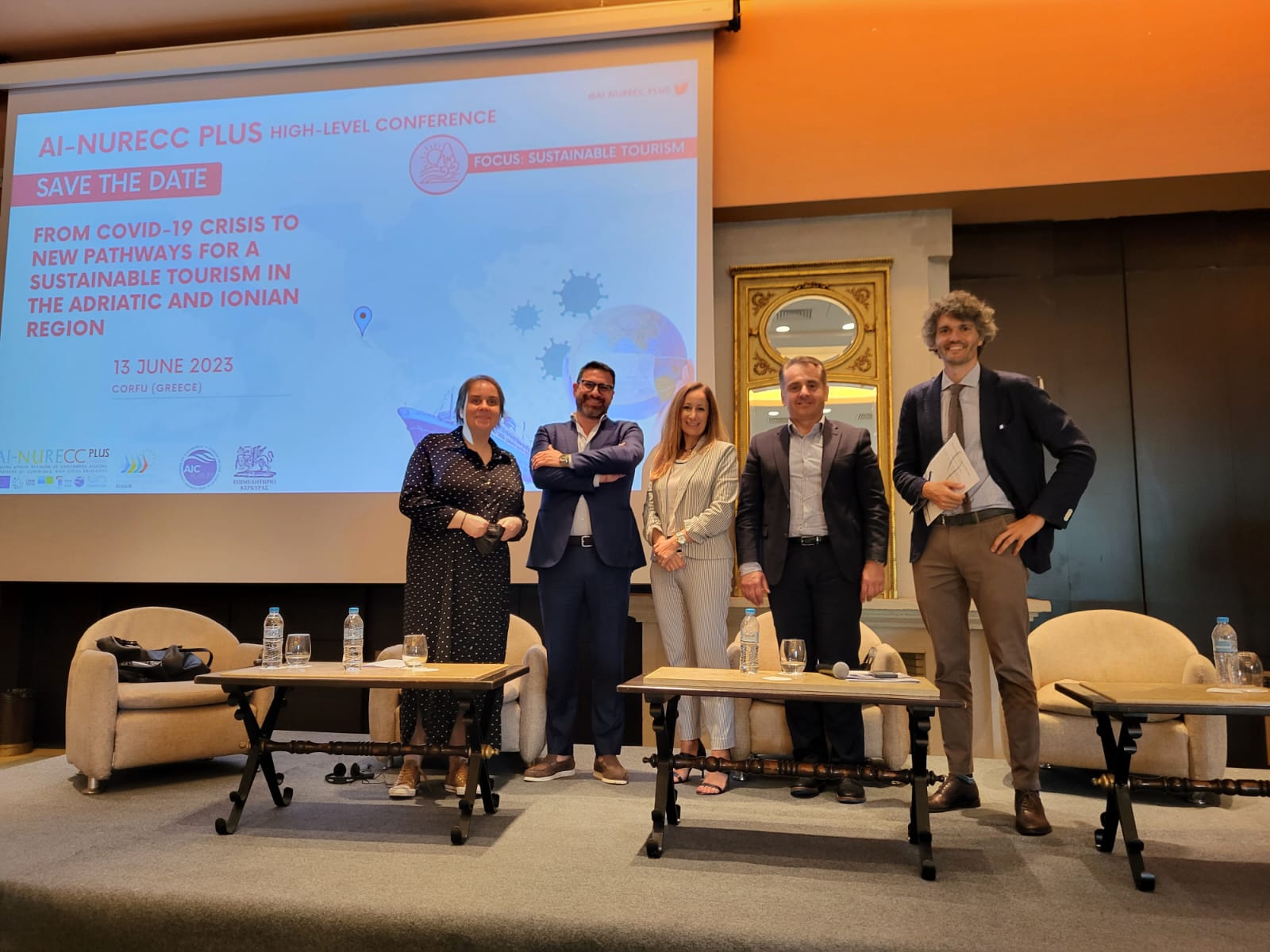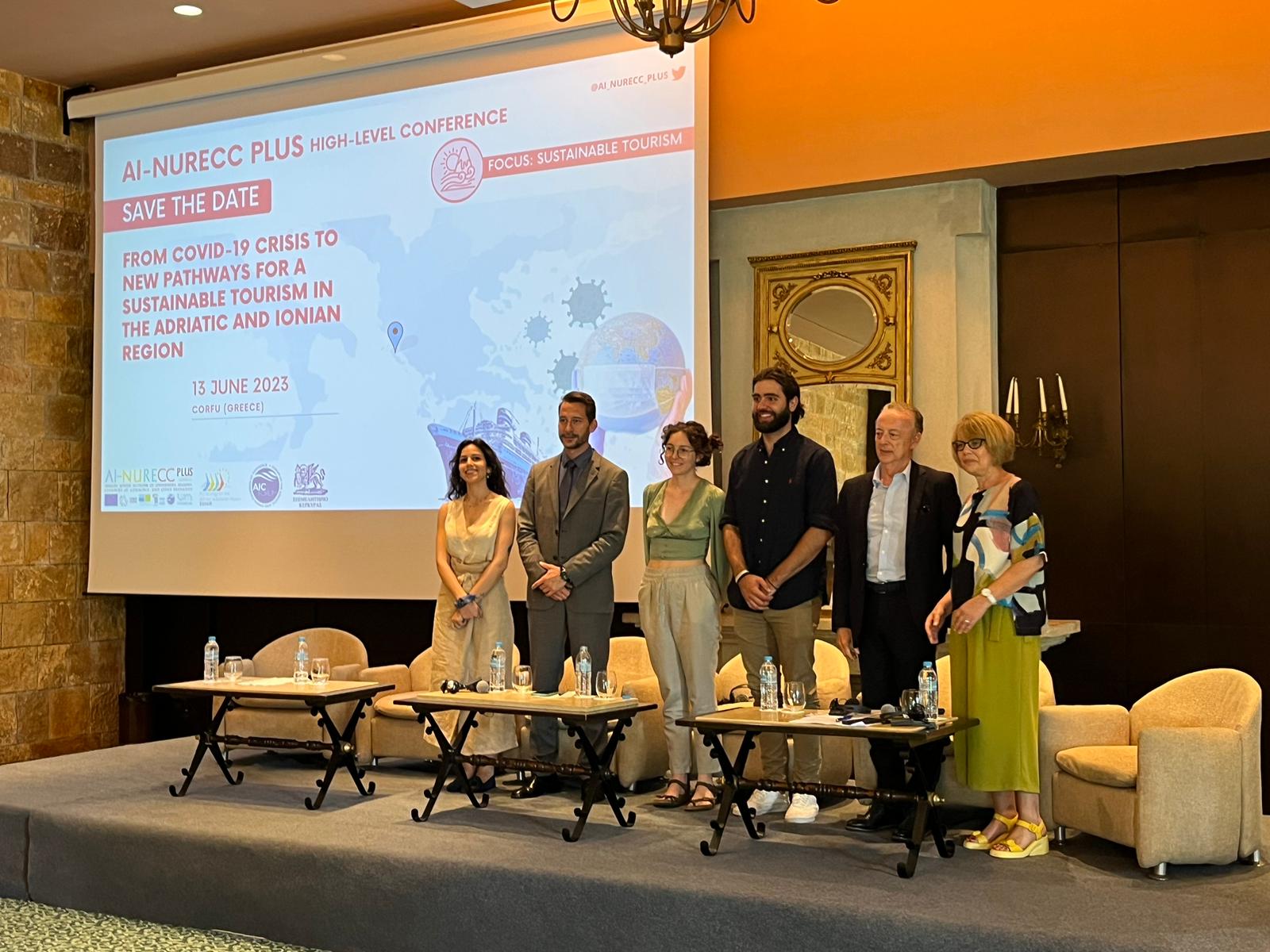In the framework of the AI-NURECC Plus Initiative, The Forum of the Adriatic and Ionian Chambers of Commerce, in collaboration with Corfu Chamber of Commerce, organised the AI-NURECC Plus High Level Conference, on the theme of Sustainable Tourism, that was held on the 13th of June 2023 in Corfu in hybrid modality, seeing the engagement of more than 100 participants.
The SARS-CoV-2 pandemic has put the global economy to the test of numerous new challenges: the economic, health and sociological crisis has brought, above all, strong negative consequences to the tourism and transport sector, representing the 10 % of world GDP, thus leading governments around the world to quickly search for solutions and remedies. However, the pandemic has also brought with it an opportunity, the renewal of a sector that has been stationary for several years. From the statement of 1 December 2022 by UNWTO Secretary General, Zurab Pololikashvili and European Union Commissioner for Transport, Adina Vălean, “The restart of tourism, therefore, presents us with a unique moment to seize opportunity from crisis […]now is the time to capitalise on such shifts in behaviour and direct our sector on a different path, one that leads to a more sustainable and resilient future”. It is not possible then to talk about tourism without talking about transport: this is what emerges through the documentation drawn up by various European bodies and institutions.
Moderating the Institutional Greetings and Opening Session was Ms. Camilla Chiappini, Communication Officer of the Forum of Adriatic and Ionian Chambers of Commerce, who gave the participants a background for the event organised under the umbrella of the AI-NURECC Plus initiative, aiming at understanding how to turn a crisis, into new pathways for sustainable tourism activities in the Region.
AI-NURECC PLUS is the network funded by the European Commission, DG Regio, which unites the main stakeholders of the European Strategy for the Adriatic Ionian Region (so-called EUSAIR) Universities, Regions, Chambers of Commerce and Cities, promoting a bottom-up participatory approach between civil society and governance. It focuses in particular on the following four sectors: Sustainable Tourism, Cultural and Creative Industries, Blue Economy and Circular Economy and, as a transversal priority, youth.
The event in Corfu, in particular, intended to analyse tourism and transport in terms of sustainable development, from the voices of the highest representatives of the sector, to then focus on EUSAIR state of art and particular means of transport, currently among the most polluting ones: namely, the cruise sector.
The meeting opened with greetings from the President of Split Chamber of Economy and of the Forum of the Adriatic and Ionian Chambers of Commerce, Joze Tomaš, who welcomed the participants both online and onsite. He then stressed the importance of the occasion: “The AI-NURECC Plus initiative is giving an important contribution during this post-Covid-19recovery time, by giving space to Civil Society Associations, the main stakeholders of the Area, which since the early 2000s, with a bottom-up approach, have strongly contributed to the official recognition of the European Strategy for the Adriatic-Ionian Region and today represent its major actuators. The Forum of the Chambers of Commerce, the association I represent, since its establishment in 2001, has pursued the objective of strengthening synergies and opportunities for the socio-economic development of the Area. To date, our association unites 39 Chambers of Commerce, belonging to 8 EUSAIR countries, soon to be 10, representing the all area, EUSAIR and is increasingly orienting its planning activities, as well as the attention of the Chamber Systems, to support companies in the transformation towards a more green and circular economy, mobility of entrepreneurs and the enhancement of sustainable tourism in the Adriatic Ionian Area”. In closing, the President thanked all the AI-NURECC Plus project partners for their commitment and wished all the participants a good and fruitful day of interventions that could hopefully allow us all to give a better response to the necessities of the Adriatic and Ionian Area.
Mr. Stefanos Spatulas, Secretary General of the Corfu Chamber of Commerce, who, on behalf of the President Mr. George Chondrogiannis, thanked once again all the representatives of the institutions and all the participants onsite and online for having taken the time to listen to an important discussion around a very interesting topic, that is sustainable tourism and the cruise sector in particular.
Ms. Rodi Kratsa-Tsagaropoulou, Regional Governor of Ionian Islands (Greece), Co-chair of the CPMR Adriatic-Ionian Task-Force, then underlined the positive message sent by the gathering of many institution that collaborate to put sustainable tourism at the centre of the public and private debate, as well as it is at the centre of the European Agenda. “This event is very important, being tourism one of the most important sectors of our area and it is essential to promote it in a sustainable way in the post Covid-19 era. We have made many improvements in the region in recent years and much more we should do. This is a topic linked to the quality of life and consequently to tourism. Another important challenge is certainly the climate one. We must all work together, by carrying out a master plan to understand the role of each implementer, including the important role of chambers of commerce. And again, the great challenge of the preservation of the Adriatic and Ionian seas is upon us: we will not have more sustainable tourism as well as good fishing and biodiversity in the area, if we don’t work together to reach those goals”.
Mr. Stavros Kalognomos, Executive Secretary of the Balkan and Black Sea Commission (BBSC), Conference of Peripheral Maritime Regions (CPMR) – AI-NURECC PLUS Coordinator offered participants a general overview on the AI-NURECC Plus Initiative, introducing the project partners and the main goals in the fields of sustainable tourism, cultural and creative industries and circular economy. He underlined the importance of networking and cooperation, which are at the heart of the Initiative and which put together public and private sector and civil society, to foster development in the area by encouraging the exchange of best practices. In particular, Sustainable Tourism, the main focusof the event, has the ability to put together different sectors and different categories of activities, and therefore needs to be the starting point to tackle the challenges arising with the pandemic.
Amb. Fabio Pigliapoco, Head of the Adriatic and Ionian Initiative Permanent Secretariat recalled the special role and commitment of Bosnia and Herzegovina, the seat of the EUSAIR and AII chairmanship during the year 2022/23. In the next future, with the Croatian Chairmanship the occasions to meet and network will be numerous. The AII has always been on the side of the AI-NURECC initiative, valuing the action of the project to foster cooperation and synergies in the area of the of the Adriatic and Ionian seabasin.
Ms. Lidija Pansegrau Hadrovic, Croatian EUSAIR National Coordinator/AII Senior Official, connected online, presented the Agenda of the Croatian Presidency, defining the Political Priorities (Transformation of the Strategy within a new macro-regional environment, Completion of the revision process towards a more social EUSAIR, Institutional linkages in the framework of macro-regional strategies) and the Thematic priorities (Greater resilience through better connectivity, Sustainable growth and tourism, Social cohesion). She also gave the participants an overview of the appointments in the agenda, among these, on the June 20th, 2023, the Launching conference of the Presidency of EUSAIR, on July4th-5th 2023, the Conference –Strong Women for a Stronger AI Region to be held in Zagreb, and many others appointments addressing nautical tourism, blue economy, biodiversity and green economy.
Ms. Alessandra Priante, Director – Region Europe World Tourism Organization (UNWTO) joining the conference online, gave the participants an overview of the UNWTO’s activities for the promotion of responsible, sustainable and universally accessible tourism. She defined the core pillars for development: sustainability, job creation and upskilling Investments and innovation, tourism for rural development and underlined the necessity of investments in human capacity building (better paid but also more fulfilling jobs, respecting the work-life balance, more opportunities to gain certifications for tourism professionals which are recognized across borders, and offering continuous learning opportunities or upskilling for example in the digital realm. The UNWTO published a Report on Tourism and Rural Development: A Policy Perspective, containing Key findings based on an international survey with 79 countries conducted from October 2022 to January 2023 and implemented the “Digital Futures Programme for Small and Medium Sized Enterprises” to provide digital training on connectivity, business growth, e-commerce, big data and analytics, payments, and security.
Mr. Tomaso Comazzi, NECSTouR Permanent Secretariat, also connected online, started by mentioning some figures: ⅙ of the European UNESCO sites are located in the Adriatic and Ionian Area and approximately ⅕ of the top 20 touristic regions are in the same area; this clearly underlines the tremendous potential in terms of heritage, art, history of our region. He then added that it is important to bear in mind that even though the Adriatic Ionian area attracts many tourists, it can’t live on tourism alone, keeping in consideration the high risk of over-tourism, and he also mentioned “resilience” as fundamental characteristic for any touristic actor, being the sector very much influenced by external factors, such as the Covid-19 pandemic, the Ukraine crisis and the climate change issue. Mr. Comazzi introduced the NECSTouR network and activities by mentioning the topics NECSTouR is tackling: Digital Transition, Policy & Regulation, Skills & Resilience, Green Transition and Stakeholder Support. The Network replied to the Covid-19 outbreak by releasing the “Vision of the European Regions for the Tourism of Tomorrow 2050” strategy, wanting to accelerate the touristic destination’s Resilience. He concludes by reaffirming the necessity to cooperate in order to create a flourishing community for a more responsible and sustainable tourism in the area.
PANEL 1: “ROUND TABLE ON MACRO-REGIONAL STRATEGY FOR TOURISM: WHAT IS THERE, WHAT HAS ALREADY BEEN DONE” moderated by Ms. Renata Tomljenović, Croatian Institute For Tourism (IZTZG) affiliated member of UNWTO, EUSAIR external expert for project development, Cultural Routes and survey on cultural tourism demand in EUSAIR, related to data-driven tourism, services for Cultural Tourism and Awareness raising on changes in tourism demand. IZTZG was funded by the Croatian Chamber of Commerce in the ‘60s and became a research institute 20 years later, when tourism started to be included in academic curricula. Its mission is the improvement and development of touristic activities, recently focusing on the Adriatic and Ionian area. Ms. Tomljenović affirms that Tourism is to be considered a Social Force by itself, but a more sustainable and responsible tourism is now a necessity in a world that is consistently facing a new crisis. Sustainability is a matter of survival.
The panel saw the interventions of:
- Ms. Georgia Zouni, University of Piraeus, Greece, Research and innovation projects and pilots on circular and climate friendly & Cultural routes passing through remote Areas (Greece) (online);
- Mr. Michele De Vita, Secretary General Forum AIC and Secretary General Chieti-Pescara Chamber of Commerce – Mirabilia digital experience (Italy);
- Ms. Alice Franchi; Mr. Emir Cirikovic, Vloggers “Made of Us” campaign – DG Near;
- Mr. Danijel Pavlović, PhD, Associate Professor at Singidunum University, Department of Tourism and Accessible Hospitality Management (Serbia);
- Mr. Athanasios Kalogeras, Research Director at Industrial Systems Institute – Project Partner InnoXenia PLUS project (Greece) (online).
The moderator asked the speakers of the panel two questions each:
Mr. Danijel Pavlović, PhD, Associate Professor at Singidunum University, Department of Tourism and Accessible Hospitality Management (Serbia)
- Considering the impact of the COVID-19 pandemic on the tourism industry, what are some key lessons or insights that have emerged regarding the importance of competitiveness and sustainability for tourism destinations? How can destinations effectively incorporate sustainable tourism indicators into evaluating their competitiveness, and what challenges might arise in this process?
Competitiveness is sometimes neglected in Tourism, but it should be a tool to ensure the economic and social wellbeing of destinations. This kind of Competitive approach is of course not the same as for other businesses. The issue of sustainability has been present for decades, but it is still at its early stages. We usually hear about economic sustainability, which is pretty much linked with competitiveness, and of social and environmental sustainability; it is important to underline that the Tourism Industry, from the ‘50s until recent years, mostly focused on economic sustainability. The question now has changed: how to maintain economic sustainability in the future, while also being environmentally sustainable? Covid-19 pandemic surely showed us that sustainability, in each of its forms, is something that needs to be planned. A project has been conducted, funded by the Science Fund of the Republic of Serbia, that analysed 300 papers addressing the theme of competitiveness in sustainability and resulted in the discovery of only 5 indicators of competitiveness measurement evaluation relating to sustainability. Future generations of Tourists will demand for sustainability, so “Sustainable” will equal “Competitive”.
- In light of the frequent crises and uncertainties faced by the tourism market in the 21st century, how crucial is it for tourism destinations to have effective crisis management strategies and systems in place? Are there any notable gaps or areas for improvement regarding crisis management and risk mitigation within the tourism industry? Additionally, what are some aspects of the tourism sector that remain unpredictable in terms of sudden disruptive impacts?
It is essential to keep in mind that Tourism is an economic activity. Economy is at the core of every country’s agenda and the Covid-19 pandemic underlined that Tourism is all about economy, in fact many countries that strongly rely on the sector had serious financial issues. The most recent WTTC publication on tourism and the impact of the pandemic mentioned risk and crisis management, disciplines that have been around for decades, and it focused on the lessons learned from the Covid crisis. Were the actors affected by the crisis acting according to the principles of risk and crisis management, or were they only trying to deal with the situation? The impression is that the sector tried to survive the critical situation and once it was over they just went back to their old habits. What was missing during the crisis was coopetition and the management of the workforce: time, money and education have been invested in the training of the workforce before the pandemic and when the crisis struck a huge percentage of tourism workers were left at home, resulting in a huge loss on investment.
Ms. Georgia Zouni, University of Piraeus, Greece, Research and innovation projects and pilots on circular and climate friendly & Cultural routes passing through remote Areas (Greece)
- As a tourism marketing and branding specialist, how can circular and climate-friendly tourism initiatives be effectively promoted and marketed to both local communities and potential visitors in the Adriatic-Ionian region? What strategies or approaches can be adopted to raise awareness and generate interest in these initiatives, considering their potential environmental benefits and contribution to local economies?
What is Circular Economy?Circular Economy is our future. It is about looking after our planet not only for this generation but also for future generations. Let’s look at what a circular economy means in relation to tourism. A tourist uses four times more water per day than a resident. As well as 40% of electricity is consumed by tourists. These are figures which show that sustainability and the circular economy are not a matter of marketing, but a matter of survival. But we also need to look at what marketing is. It’s not to advertise, sell, deceive, brand, and promote. Real marketing is telling the truth to the customer. According to the founder of Airbnb, Mr Brian Chesky, for the past two years we have been experiencing a revolution in the way we live and work. We are all more demanding.We have experienced a global shock; we have not recovered. Most of us have gone out deprived for travel. Climate change is the biggest challenge facing the world right now. So, consumers and customers are demanding transparency in our sustainability and environmentally friendly practices. Consumers and customers, beyond the benefits a product or service offers them, focus on whether the brand has meaningful, ethical values, such as: empathy, solidarity, respect, and humanity. And this will be reinforced in the coming years and will become a daily reality. And this is where the role of research is important, as what is not measured is not managed. And this is also where the role of research is important, as what is not measured is not managed. And this is where cooperation between universities and other institutions is needed, as well as specific projects such as AI-NURECC PLUS.
- Cultural routes can foster intercultural dialogue and cooperation among different stakeholders while enhancing tourism’s social and cultural benefits. In your experience, what are some effective ways to engage local communities, tourism businesses, and visitors in developing and promoting cultural routes in the Adriatic-Ionian region? How can these routes be designed and managed to ensure meaningful interactions, positive experiences, and sustainable benefits for all involved parties?
Culture can only change with targeted education and training. An example of the importance of cultural routes may be that two years ago, when the EUSAIR Cultural Routes strategy for the Council of Europe was made, a survey was conducted: the stakeholders, from the then 8 countries, talked about the sea, the air, the nature, and the people and their hospitality. Because in this case for branding, you don’t make a brand, but you highlight the identity that exists. Only through collectivity and collaboration with stakeholders can there be sustainability.
Ms. Alice Franchi, Vlogger “Made of Us” campaign – DG Near;
- As a climate activist and advocate for sustainable tourism, you emphasise the importance of respecting the culture and hospitality of the countries we visit. How can tourists actively engage with local communities in the Adriatic-Ionian region to ensure their travel experiences contribute positively to the social and cultural fabric of the destination?
The act of “discovery” and the need of getting in contact with different cultures has always been part of human nature. In recent years, everyone is using the word “sustainability” in any different context, and there is a huge risk of it losing its meaning. “To me, sustainability is the top of the mountain and there are of course many ways to reach it; some will take more time, some will get you there quickly. But the final goal is to reach the top”. The goal of the “Made of Us” Campaign is to unite in diversity. Travelling with a local certainly makes a huge difference, since it allows us to really dive deep into the culture and the way of living. That’s what sustainable tourism is all about: respecting the hospitality of a country.
- You mentioned that sustainable tourism is like reaching the summit of a mountain, with various steps and difficulties along the way. In the context of the Adriatic-Ionian region, what specific challenges or obstacles need to be addressed to promote and achieve sustainable tourism, and how can innovation play a role in overcoming these challenges?
The role of Education, at various levels, is essential. My generation is very focused on sustainability to the point that it often becomes part of our curricula at high school and university but, nevertheless, we are still late. The current situation is not promising: culture and education are the engine that will lead us to change and towards a more sustainable way of living, but they are not yet at the stage where they can start the engine. Networking is of course essential, but we must know that we can’t face this emergency alone (at a business level), we need the support of the institutions, policy makers, local communities and so on. Everyone can and must do their part.
Mr. Emir Cirikovic, Vloggers “Made of Us” campaign – DG Near
- Plav, Montenegro, is currently experiencing a surge in outdoor-based tourism. It brings social and economic benefits, improving the QOL for locals. At the same time, outdoor tourism spreads people over a vast area, not necessarily prepared for visitors, posing a range of adverse environmental impacts. How do we strike a Balance? 2. As we have emerged from the C19 crisis, we have witnessed a surge in demand for nature-based experiences, offering many entrepreneurial opportunities. To what extent can the private sector, in these emerging tourism destinations be entrusted to manage the tourism business sustainably?
The question of balance is by far the most difficult question to answer, in any kind of domain. “In my hometown, and Montenegro in general, we are experiencing a boom in outdoor tourism. As it has already been said, competition is a key factor and it can also mean finding the right funds from internal and external sources, to preserve the destinations. ROI in sustainability takes time. It is advisable to advocate a slower and thoughtful development and not rush trying to exploit the favourable moment, risking to destroy the very reason why tourists are attracted by a specific destination”.
Mr. Athanasios Kalogeras, Research Director at Industrial Systems Institute – Project Partner InnoXenia PLUS project (Greece) (online)
- As elsewhere, the sustainability of tourism has been a concern of the industry for the last three to four decades. For most of that time, policies and discussions were rhetorical until very recently, when activities of many actors converged to make real progress, as sustainability is not an option but an urgency. How can technology be of assistance in tourism-related activities?
ICT is applicable to a number of domains, including tourism and of course sustainability. Sustainability is a very complex topic, involving quite contradicting elements, and the topic of balance is of key importance. “Technology might help by considering data, but how do we measure sustainability? There are a number of indicators, ETIS to mention one, relating to sustainability in tourism, but sometimes data is not available for certain destinations, or it is not sufficient and measurements become impossible. It could be useful to consider a Biological Science old concept: Carrying Capacity (that identifies the limits of acceptable changes that can be introduced in an ecosystem), that could help to measure the impact of a specific action on a touristic destination. This requires a participatory approach, so also the local population would be involved in the decision making process”.
- Obviously, we must take a new approach to tourism management to contribute to global sustainability goals and ensure the tourism sector’s survival and resilience. How does the tourism sector perform in terms of innovation, and what can be done to make it crisis resistant or resilient?
An important question is: how can we make a destination more resilient in case of a crisis? A touristic destination is a complex ecosystem ; when a crisis hits a particular area, the ecosystem will modify accordingly and find a new point of stability. So, in order to become more resilient, there are three important questions to ask: 1. What is the starting point?; 2. Where do we want to go? What is the final goal?; 3. There are many ways to reach the goal; which one is the most efficient? Of course there also are criticalities since this is a participatory approach that will need upskilling and reskilling of the actuators and, of course, innovation will play an important role in building a more resilient tourism. We are living the so-called 4th industrial revolution, with production models that are focused on advanced technology and massive data collection and analysis; a system that could certainly also be applied to tourism.
Mr. Michele De Vita, Secretary General Forum AIC and Secretary General Chieti-Pescara Chamber of Commerce – Mirabilia digital experience (Italy)
- As the Secretary General of Forum AIC and part of the Mirabilia Network, could you elaborate on the role of collaboration and synergy among the ItalianChambers of Commerce in promoting the UNESCO sites in the Adriatic-Ionian Region? How does mapping lesser-known UNESCO sites and developing digital material contribute to the region’s joint promotional activities and positioning asa unique tourist destination?
The experience of Mirabilia started in 2012 and it gathers now Unioncamere and 21 Italian Chambers of Commerce, sharing the goal of promoting the less known UNESCO sites of the territory and subsequently also the areas around the sites. In 2016, in Italy, there was a reform of the Chambers System, giving Chambers of Commerce a new and stronger range of action in the tourism sector; the Mirabilia Network forms part of this framework and this new competence of the Chambers. The Network is now expanding from being an Italian reality, to a more wider and international spectrum: in fact it signed a Memorandum of Understanding with Chambers of Commerce in the neighbouring France and another one with the Forum of Adriatic and Ionian Chambers of Commerce that resulted in the mapping of the UNESCO sites in the area and, from that, the realisation of promotional videos to promote the macro region as a unique touristic destination. “That was possible thanks to the precious collaboration of the Chambers members of Forum AIC, who supported us in the collection of the permissions, issued by different entities in each country, and supported the crew that travelled to the area in the actual production of the videos”.
- The Mirabilia Network focuses on the promotion of National UNESCO sites in Italy. What are some key challenges and opportunities in promoting and enhancing the visibility of lesser-known UNESCO sites in the Adriatic-Ionian region? How can the network and Forum AIC’s activities effectively contribute to raising awareness and attracting tourists to these sites?
As Mirabilia, we operate following this direction: promotion, education and innovation. With regard to the Promotion activities, each year we launch a call for cultural tourism (with a section devoted to Food & Drink activities) to allow hundreds of companies, coming from the areas where the UNESCO sites are located, to meet buyers coming from all over the world. For the Education point of view, we organise a number of webinars targeted to both employees of the Chambers of Commerce part of the Mirabilia Network, but also entrepreneurs from the area, moreover we promote a Master, that addresses the topic of specialised professional figure in the Hospitality and Catering industry, implemented by the Perugia University. Regarding Innovation, we strongly rely on the “PID – Punti Impresa Digitale”, service structures initiated by the Ministry of Economic Development, whose objective is to help local micro-small and medium-sized enterprises to seize and understand the opportunities associated with the use of new digital technologies; and we promote an award called “Top of the PID” during which we recognise the best enterprises that applied digitization principles in their activities in the Tourism sector. During the Round Table, the word Sustainability has been defined in various ways, for Mirabilia it is declined in the respect and preservation of the historical and territorial heritage of our area. From this desire, the Mirabilia Network and the Forum of Adriatic and Ionian Chambers of Commerce collaborated in the creation of dissemination material for an even more digitised promotion of the area.
Ms. Tomljenović wrapped up the Round Table by reaffirming that the Tourism industry certainly needs to survive critical situations at an economical level, and it is already on the way to recovery. Younger generations are for sure more responsible when it comes to sustainable behaviours and they also represent the future of the sector, that will therefore present a stronger demand by tourists for sustainable solutions. Competitiveness is going to be part of this framework. In conclusion, sustainability is a process that will never end and will never be perfect. When a certain level of sustainability is reached, it is already time to start working to reach another benchmark.
PANEL 2: “ROUND TABLE ON CRUISE AND WATERBORNE TRANSPORT: THE IMPACT OF THE COVID AND THE GREEN DEVELOPMENTS OF THE SECTOR”
Introduced and moderated by Mr. Anthony La Salandra, Director “Risposte Turismo”. Mr La Salandra introduced the topic of the Round Table by mentioning an event organised by Risposte Turismo in Dubrovnik, the “Adriatic Sea Forum” during which the topic of Ferry traffic was discussed. According to data contained in the Adriatic Sea Tourism Report 2023, 2019 saw almost 6 million passengers in the Adriatic area, 2022 not even 4 million; it is almost -40%, mainly due to the pandemic situation and the Adriatic area is also recovering way more slowly compared to the Mediterranean area. Nevertheless, the forecast is not negative, with an expectation of recovery for 2023 that will bring us back to the results reached in years such as 2017, before the pandemic.
The panel saw the interventions of:
- Ms. Elisabetta De Nardo, VP Port Development, MSC Cruises (Italy)
- Ms. Maria Deligianni, National Director, Eastern Mediterranean, Cruise Lines International Association (CLIA), (Greece) – (online)
- Mr. Zoran Martinoski, President of the Prime Blue ESG Institute (North Macedonia)
- Mr.Alkis John Corres, Business and Academia, Professor of Ship Management and Chartering, International Shipping Business Consultant, Maritime Policy Advisor “Cruise Ports – The case of the Eastern Mediterranean” – (online)
- Mr. Antonio D’Amore, Special Commissioner of the Brindisi Chamber of Commerce (Italy)
- Ms. Georgia Chantzi, International Centre for Black Sea Studies – ICBSS, coordinator of the CulTourE4Youth and Black Sea Cruise projects
The moderator asked Ms De Nardo for cruising, Mr D’Amore for nautical tourism and Mr Martinoski for yachting, how much, in their opinion, the priorities and needs of their organisation and the stakeholders they work with have overall changed following the pandemic situation.
Ms. De Nardo stated that the Covid-19 pandemic represented a catastrophic event and as declared many times, the tourism sector was the most affected by it. The losses were uncountable and they are lost for good. “One of the advantages for a ship company is the possibility of, quite literally, moving the ships away from a critical area, for example in case of a war; with the pandemic, we completely lost this competitive advantage. We certainly learned many lessons though, we strengthened our working relationship with local communities (local port authorities, chambers of commerce, boards of tourism, tour operators, border police, and many more) because to us it’s the people and the cooperation between people that build a strong business”.
Mr. D’Amore confirmed what Ms. De Nardo said, in fact the port of Brindisi hosted a number of MSc Cruise ships and their crew during the pandemic period, underlying the importance of cooperation and collaboration with local communities. The needs and also the expectations of the tourists – and tourist companies- have certainly changed; the ports have become a springboard for the entire area to be discovered by the passengers coming from the sea. Moreover, big ships companies can be good interpreters of the infrastructural needs of the ports, since it is well known that the most negative environmental impact is due to the stationing at the ports of big cruise ships; so having access to effective solutions via different sources, such as for example the PNRR (Piano Nazionale di Ripresa e Resilienza) in Italy, becomes of paramount importance. Of course national investments or European funds alone aren’t enough without a political engagement together with stakeholders and companies that have to reform their practices. The Cruise sector is a big source of economic income for the port of Brindisi, also in terms of services offered to the community and so on, but Nautical Tourism, which is also flourishing in our area, can also have positive effects in terms of employment opportunities on the territory. The two sectors are substantially different, but they surely coexist and have similar needs when talking about port infrastructures.
Mr. Martinoski made a distinction between different categories of yachts; the small ones below 24 metres, normal sized ones above 24 metres and the big ones above 34 metres: small, yacht and mega yacht. The small segment is stagnating, while the mega yacht segment presents a lack of production capacity that can’t satisfy the demand of the market. There currently are 6 thousand mega yachts in the world, 70% are located in the Mediterranean area and the migration rate is declining, so they are staying in the area longer that they used to in the past and, considering that on an annual basis, each of these yachts spends 10% of its value in various services such as fuel, maintenance, insurance and so on, we can imagine the positive economic impact they have on the marinas and ports where they station. In terms of the 2050 objective, sustainability is no longer a “matter of will”, it is now becoming mandatory and each and every participant in the value chain will need to comply.
In addition, the moderator asked De Nardo and Martinoski, being responsible for operations worldwide, if they think the Adriatic and Ionian- characterised by famous tourist destinations such as Dubrovnik, Venice, Kotor and many others- is unique or are certain dynamics similar worldwide?
Mr. Martinoski affirmed that the region is certainly unique and it has been evolving recently from a touristic point of view, with high level structures that need to comply with certain standards and this also applies to sustainable practices, otherwise access to funds and even access to market would be prevented, since companies could be denied access to ports and marinas and so on.
Ms. De Nardo confirmed that the region is seeing a regular steady growth and affirmed that it is a key destination for MSC Cruises with 1.5 million passengers each year. It is a very diverse destination and one of the first to reopen to tourists after the stop caused by the Covid-19 pandemic.
The moderator then proceeded asking the speakers of the panel two questions each:
Ms. Georgia Chantzi, International Centre for Black Sea Studies – ICBSS, coordinator of the CulTourE4Youth and Black Sea Cruise project
- We’ll be talking later about the Black Sea Cruise Project. In this first round I’d like to ask you from the research perspective of the International Center for Black Sea Studies if and how research topics and key issues of cruise and waterborne transport are changing after the pandemic. Where is research heading now and which are the new big issues in research?
Covid-19 was critical, as it is the War in Ukraine. Blue Economy is our main priority, as it is a priority also for the Adriatic and Ionian Area, since it is an employability and GVA generator for the countries in the Areas. Sustainability for us is an operational concept that needs to be applied to each and every aspect of the touristic sector. Should we identify a question that needs to be answered: what level of ROI would we have, if we started implementing, in a more structured way, the cruise sector in the Black sea?
- You’ve been working on sustainable small-scale boating and the case of black sea. What are the key challenges in fostering small-scale potentials vs. consolidated business models based on larger economies of scale in maritime transport?
Covid-19 shook us all to the core; we were not ready and we are still trying to adapt in the short and medium term. What has been mentioned earlier about the lack of workforce is true everywhere. The market has changed after the pandemic and so have the expectations and necessities of the employees. It is necessary to reskill and upskill them and offer them the tools to respond to the needs of the market. The CulTourE4Youth project has been implemented as a pre-feasibility assessment to see what the value and potential of smaller scale boating is in the Black Sea; although it is an uprising touristic destination according to the UNWTO; in terms of cruising the numbers are not satisfactory. The Region has many smaller ports and marinas, so the improvement of small boat tourism, if planned properly, can bring better value to local communities while also preserving the local ecosystem.
Mr. Alkis John Corres, Business and Academia, Professor of Ship Management and Chartering, International Shipping Business Consultant, Maritime Policy Advisor “Cruise Ports – The case of the Eastern Mediterranean” – (online)
- We hadn’t touched yet the shortsea and ferry topic but in areas such as the Adriatic and Ionian it’s a key element not only for tourism and we had seen how the traffic was much more resilient during the pandemic. Was it mainly benefiting from difficulties with other forms of transportation (I refer mainly to airlift) or do you expect this trend to continue and ferries to keep growing or a bounce back is something we should be prepared for?
Motorways have been called the “arteries of a nation”, in the same way ships routes are implementing the same function over weather. One criticality could be that ships are sometimes too old: the average age of the ships circulating in the EU is considerably higher than the age of the ones circulating elsewhere. One reason for that is that those are usually smaller ships than nevertheless have to cover expenses that are similar to those of the big ships, but due to their smaller dimensions and cargo capacity, of course incomes are not equal. It is also worth mentioning that it is hard if not impossible to introduce innovative modifications to comply with the latest environmental legislations, it is not financially sustainable. To answer the question, especially if we are talking about islands, such as Corfu which is hosting the event, it is understood that the cruise sector will always have a certain level of resilience whether there are flights covering the area or not, and we can affirm that ferries are more resilient than other means of transport under certain circumstances, such as for example the pandemic
- Eastern Med is experiencing a very strong recovery (higher than Adriatic-Ionian and other Med areas): was it underperforming before or is benefiting from some particular new conditions?
Things are constantly changing; the eastern Mediterranean has benefitted from increased activities of the countries coming from the Arab world and the far east, attracted by destinations that provided entertainment. We have seen this trend in Greece, for example, with extraordinary turnovers in islands that offer the same kind of tourist attractions. For sure those conditions are not the same that we can find in the rest of the med area or in the Adriatic and Ionian Area. Although we can’t really say if it was underperforming before or not.
The moderator asked the same question to Ms. Maria Deligianni, National Director, Eastern Mediterranean, Cruise Lines International Association (CLIA), (Greece) – (online)
Before Covid-19, the eastern Med experienced a drop in cruise ships arrivals, mostly because of security instability in the region. The pandemic did help with the growth of the region that saw itself playing a very important role in the restart of the business globally. Greece, for example, was one of the first countries to open its ports and welcome cruise ships from all over the world. Of course, the region still needs to invest in the sector; when comparing the eastern med with the western med, the latter is a market that is already well established, while the former represents an open window rich in opportunities for growth.
- Let’s move to the second key topic today, green developments of the sector: the cruise industry is moving fast, and in a certain way even faster than ports and territories. What was really interesting is that in comparison to other tourism sectors, cruising hadn’t stopped its innovation traction even during Covid-19 with new ships coming out and new prototypes (I refer to ammonia tests or other fields of innovation). Do you think cruising is today leading a green transformation pushing other stakeholders to follow? What are the main results/outcomes of this commitment you’re more proud of?
The green transition of the sector has always been the number one priority for the Cruise Industry; even during the pandemic CLIA adopted a sustainability strategy composed of three pillars: Sustainable transportation, Sustainable Hospitality service and Sustainable destination stewardship. The Cruise Business is a complex one and many initiatives need to be put in place in order to reduce its carbon footprint, but what it’s surely necessary is the availability of alternative fuels on a large scale.
Ms. Elisabetta De Nardo, VP Port Development, MSC Cruises (Italy)
- MSC christened last week the new MSC Euribia: can you tell us more about the green characteristics of this cruise ship? Is it already expressing all its potential or is there something that ports and territories should develop? In addition – if we look at the MSC Cruises commitment to 2030-2050, what can be the main obstacle(s) in achieving the targets ?
As ship owners we represent 3% of all men-generated emissions in the world. Only 3% of this 3% comes from the cruise sector, but we are still very committed to the environmental issue. Our sustainability program is based on 4 pillars: planet, place, people and procurement; MSc Euribia is certainly a milestone: Euribia runs on bio LNG (liquified natural gas) and its maiden voyage from her shipyard berth in Saint-Nazaire, France, to Copenhagen represented a net zero greenhouse gas emission leg, the world’s first. Unfortunately it is not possible to always have zero emissions, since biofuel is not always available, which represents a great challenge, together with the lack of infrastructures such as ports, that are not ready to host new generations ships.
Mr. Antonio D’Amore, Special Commissioner of the Brindisi Chamber of Commerce (Italy)
- Moving to the perspective of companies, as you are entrepreneur and commissioner of a Chamber of Commerce: how investing in green developments is only a matter of big companies with enough economic leverage? Are medium and small companies losing a bit the momentum in being part of a green transformation of the sector?
Big companies have the power and possibility to involve institutions, policy makers, and through them, the citizens in general, towards a more conscious green transition. Big companies have the means to invest in R&D and find new approaches to reach a more sustainable economy. Goals and strategies need to be shared among big and small companies and citizens, in order to change the paradigm.
Before the final wrap-up, the moderator asked the online panellists: Should you have to choose 3 keywords for a bright future for Adriatic and Ionian cruise and waterborne transport, which ones and why?
Ms. Deligianni:
1- Growth – since the region has potential for further growth
2- Sustainability – the cultural heritage needs to be preserved and this growth needs to take place in a sustainable way
3- Cooperation – the only possible way to grow is a solid cooperation between the Cruise lines, ports, governments and local authorities.
Mr. Corres:
1- Passengers’ safety
2- Environmental awareness
3- Realisation of priorities
To conclude, during this event, the most important message from the speakers is the urgency and necessity to collaborate within wider networks of stakeholders: ship-owning companies, ports and most importantly the policy makers and local authorities, in order to provide the most efficient solutions in terms of services offered, but also and most importantly in terms of environmental sustainability. The path towards sustainability doesn’t have a “finish line”, since it represents an everlasting engagement that needs to involve every aspect and every actor of the value chain.
